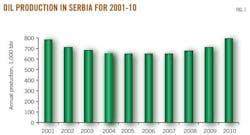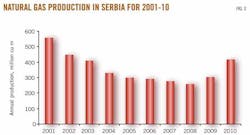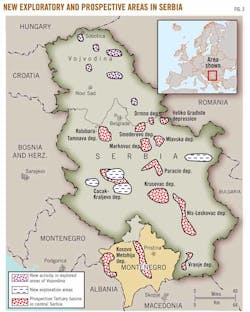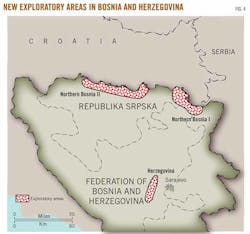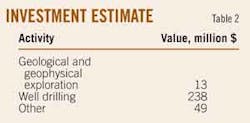Exploration, production pace faster in Serbia, Bosnia and Herzegovina
Vesna Karovic Maricic
Dusan Danilovic
Veselin Batalovic
Branko Lekovic
University of Belgrade
Belgrade
Oil and gas production has declined in Serbia in the last 3 decades due to depletion of existing reserves and low level of exploration. Domestic production makes up one fifth of Serbia's energy needs, so the country is highly dependent on imports.
Such an unfavorable situation in the Serbian petroleum sector has gradually changed since 2009, however. In 2009, GazpromNeft of Russia bought 51% of the shares of Petroleum Co. of Serbia (NIS). Production in 2010 amounted to 8.76 million bbl of oil equivalent, an increase of 30% compared with 2009.
In order to increase its reserves and production, NIS-GazpromNeft has invested in many exploration and production projects in northern and central Serbia and in neighboring Bosnia and Herzegovina. Also, in 2011 the Jadran-Naftagas joint venture has been formed for conducting exploration projects in Bosnia and Herzegovina.
According to the latest estimate, it is considered that the potential of recoverable resources at the territory of Serb Republic in Bosnia and Herzegovina is 73-87 million boe. The oil and gas exploration results in Bosnia and Herzegovina justify further exploration and indicate the realistic possibility of finding commercial accumulations.
This article reviews recent and planned oil and gas exploration and production activities in Serbia and in the Serb Republic in Bosnia and Herzegovina.
Balkan oil and gas background
The Republic of Serbia, a country in southeastern Europe and on the western Balkan Peninsula, belongs to the group of countries that are not major petroleum producers or consumers.
Serbia's crude oil proved reserves of 77.4 million bbl rank 76th in comparison in the world, and natural gas reserves of 1.7 tcf rank 65th by 2010 estimate.
Despite being small on a world scale, Serbia's resources have a certain regional importance. Also, according to the data on current and future exploration, the potential is promising. Serbia has, particularly due to its geographic position, an important role in the future of energy supply in Europe.
The Serbian petroleum sector has been owned by public enterprises for decades. The state company NIS-Naftagas, which started oil and natural gas exploration and production in the 1950s, was restructured in 2005 into the public enterprise Petroleum Co. of Serbia (NIS) and became one of the largest petroleum companies in southeastern Europe.1
Liberalization of the energy market in the last decade and the planned integration of the Serbian energy market into the European Union energy market have attracted important foreign investments in Serbia's oil and gas sector, including GazpromNeft's controlling stake in NIS.
Investments in new improved oil recovery technologies and better management halted the continuous decline in oil and gas production in 2009. Planned production is 30,000 boe/d in 2011 compared with 24,000 boe/d in 2010.2
NIS-GazpromNeft, to reach its goal of increasing oil and gas production, has many projects under way in northern and central Serbia and is expanding into Bosnia and Herzegovina. According to its long-term strategy, company aims to triple current production by 2020 in Serbia and Bosnia and Herzegovina.
Bosnia and Herzegovina is also highly dependent on imported petroleum products, but it has a processing capacity in two refineries, large stock tanks, and a modern sales network with a number of gas stations. The infrastructure provides a framework for favorable exploration results.3
Bosnia and Herzegovina long has been considered a country with a high resource potential. According to the latest estimates, the potential of the Serb Republic in Bosnia and Herzegovina is 73-87 million boe that could support production of as much as 15,600 boe/d.4
For those reasons, the NIS and Neftegazinkor, a subsidiary of GazpromNeft, created the Jadran-Naftagas joint venture in 2010 to develop prospective sites in Bosnia and Herzegovina. The JV started a 3D seismic survey in 2011, will drill the first exploratory wells in 2012, and by 2014 plans to start production.
Oil and gas production in Serbia
Ninety percent of the discovered oil and gas reservoirs are in the northern part of Serbia, called Vojvodina, namely the Banat depression of the Pannonian basin. The other producing fields are in central Serbia, south of the Sava and Danube rivers.
Oil and gas exploration in Serbia began in 1947 and has included regional gravimetric, magnetic, and seismic surveys (41,000 line km-2D and 460 sq km-3D) and drilling of 2,032 exploration and development wells. The wells discovered 100 oil and gas fields with about 280 reservoirs.5
Most of the oil and gas fields in Vojvodina and central Serbia are small in terms of production rate.6 Exceptions are Velebit, Kikinda, Elemir, Mokrin, and Itebej fields that belong to the larger oil fields of the Pannonian basin and to the average on a European scale.
Most of the fields are in structural traps in Lower and Upper Pontian (Neogene) sediments. Many previous geological studies were focused on structural traps in underlying Tertiary sediments. Besides that trap type, some stratigraphic or lithological traps were accidentally discovered, and a large number of these nonconventional traps are in structures with negative hydrocarbon crests. Unconventional gas deposits have also been discovered in Vojvodina.
In central Serbia, small oil and gas reservoirs were discovered in Tertiary sediments.7 Petroleum production in this part of Serbia, which is considered insufficiently explored, began in 1990. The most recent geochemical studies identified Mesozoic-Paleozoic structures as potentially hydrocarbon-bearing.
Oil and gas production in Serbia peaked in the 1980s. Oil production declined until 2006 and gas production fell through 2009. Today, oil and gas are produced from 52 fields with 800 wells in 135 reservoirs.
The last large oil discovery, Turija-North, was in 1987. Since then, the several small, mostly gas-condensate reservoirs (Martonos-West, Martonos Farm, Chestereg, Melenci, etc.) were found.
In 2006 the oil production decline was stopped due to application of stimulation methods and production optimization.8 Compared with 2008, oil production rose 4% in 2009 and 12% in 2010 (Fig. 1).
Serbian natural gas production compared with 2008 was up 19% in 2009 and 30% in 2010 due to new field discoveries and improved reservoir management (Fig. 2).
Future production rates will depend mainly on the results of further exploration and application of new exploitation technologies.
New exploration in Serbia
The US Geological Survey in 2006 estimated that the Greater Hungarian Plain, as a part of the Pannonian Basin System, has a 95% probability of containing at least 343 million boe and a 5% chance of holding as much as 1.387 billion boe of undiscovered, recoverable resources.
One third of this petroleum system in Tertiary sediments underlies northern Serbia, loosely implying that its share of the resource ranges from 117 million to 460 million boe.
Besides conventional hydrocarbon resources there are unconventional resources, particularly of tight gas.9
Discovery of oil and natural gas requires the development of a modern petroleum-geological exploration concept that is based on the latest knowledge about geological setting and geodynamic development of the Pannonian basin's southeastern part and the Balkan Peninsula. It also would depend on the presence of Pretertiary hydrocarbons and experiences of geological research in the wider region (Italy, Albania, Romania, Austria, Hungary, and Bulgaria).10
The basic elements of a proposed petroleum-geological exploration program in next 10 years mostly depend on the results of planned regional exploration. Implementation of regional explorations will be carried out in phases where every next phase will depend on results of previous.
The first phase of regional exploration would involve 1,000 line-km of geophysical surveys, possibly supplemented by gravimetric-magnetic and magnetotelluric investigations. Field and laboratory testing of outcrops and detailed geochemical, petrological, biostratigraphic, and sedimentologic research is also needed.10
Development of new petroleum-geological exploration in Serbia on the basis of regional exploration results will be directed to:
• The wider zones of tectonic contact and overthrust of the basic structural-tectonic units in Serbia.
• The broad regional areas of shallow continental subduction zones.
• The wider zones of tectonic faults (reverse and radial) along which were formed by synsedimentation younger Neogene-Quaternary depressions.
Activity in densely explored northern Serbia is focused on satellites of existing fields. The main exploration techniques are 3D and detailed (density greater than 2.5 km/sq km) 2D seismic surveys. Here, the probability of success must be at least 70%.11
It is considered that greater discoveries are possible in insufficiently explored areas in the deeper parts of the basin (especially in tectonic collision zones) and in central Serbia. The new discoveries should be searched in structural and stratigraphic traps of unexplored Mesozoic and Paleozoic sediments. Exploration for structures in deeper sediments, unconventional reservoirs, and nonstructural traps represent projects of high risk. For that reason, the probability of success is considered to be 30%.11
Regional geophysical surveys started in the Cacak-Negotin area of central Serbia and a detailed seismic survey began in the Cacak-Kraljevo area in 2010. The first exploratory wells are to be drilled after the data are interpreted.
Areas of new exploration projects in Vojvodina and central Serbia are shown in Fig. 3. Defined prospective Tertiary basins in central Serbia are presented also, where in the Smederevo and Drmno depressions a few gas fields have been discovered.12 13
New exploration in Bosnia and Herzegovina
In Bosnia and Herzegovina oil and gas exploration has been carried out for more than a 100 years, but commercial accumulations haven't been found.
In this region several domestic and foreign companies (INA, Energoinvest, Amoco, ECL, GECO, EXLOG, and others) were involved in petroleum exploration that can be grouped into several periods:
(1889-1915)—three wells were drilled to 130-140 m and registered the first traces of oil.
(1929-41)—44 wells were drilled to 50-2,025 m, and a small oil reservoir was discovered that produced about 1,000 tons through six wells.
(1948-61)—45 wells were drilled to 250-1,750 m in the Tuzla basin, Posavina, and Semberija with registered oil occurrence.
(1963-73)—four deep wells were drilled in northern Bosnia inner and outer Dinarides and registered oil occurrence.
(1973-92)—extensive geochemical, geomagnetic, geophysical, seismic, and magnetotelluric surveys in the projects named "Northern Bosnia" and "Dinarides" have confirmed the presence of petroleum.
The Northern Bosnia project involved the exploration of Bosnia's northern area which includes southern parts of the Pannonian Tertiary basin, i.e., inner Dinarides Mountains. The north border is the Sava River, and the western and eastern borders are the Una and Drina rivers, respectively.
The Dinarides Project, carried out by Amoco in 1989-92 with a $12 million investment, covered the central and outer Dinarides Mountains, i.e., the terrain of central Bosnia (Sarajevo-Zenica basin), and Herzegovina. The project defined prospective structures close to Trebinje, Stolac, Nevesinje, Mostar, and a "megastructure," Dreznica.
The results indicate oil and gas potential in the northern region at 2,000-4,000 m and in the south part of Bosnia (Dinarides area) at 4,000-6,000 m.14
At the present stage of exploration of northeastern Bosnia, the oil resource estimates15 for four prospective sites are:
1. The area south from Samac (22 sq km), about 67.2 million bbl.
2. The area southwest from Orasje (37 sq km), 44.5-113.2 million bbl.
3. The Tinje River valley in the Tuzla region (25 sq km), 104.4 million bbl.
4. The area of Lopar (21 sq km), 86.9 million bbl.
In 2011, the Jadran-Naftagas joint venture has continued oil and gas exploration in Bosnia and Herzegovina within the territory of the Serb Republic. Its program includes geological exploration, 2D and 3D seismic surveys, and drilling 17 exploratory wells. The petroleum-geological exploration concept is similar to the program that NIS-GazpromNeft conducted in central Serbia last year.
New exploration in this region is focused on three perspective sites: northern Bosnia I, northern Bosnia II, and eastern Herzegovina (Table 1 and Fig. 4).
The estimate of recoverable resources in this region is 73-87 million boe. The investments in geological exploration program 2011-13 will be $9.2-17.6 million with a maximum variant of $300 million of investments (Table 2). The dynamic production plan stipulates the beginning of petroleum exploitation in 2014.15
Acknowledgment
This article is the result of the project financed by the Ministry of Education and Science of Republic of Serbia (Project No. 33001). We thank the ministry for the support.
References
1. Petroleum industry of Serbia, company background, 2011 (http://www.nis.rs).
2. Kravchenko, K., interview by Kommersant, 2011 (http://www.gazprom-neft.com/press-center/lib/3967).
3. FMEMI expert group, "Strategic Plan and Program of Energy Sector Development of the Bosnia and Herzegovina Federation, Sarajevo, Bosnia and Herzegovina, 2009 (http://www.fmeri.gov.ba).
4. Group of authors, "Draft document of Energy Development Strategy of the Serb Republic until 2030," Banjaluka, Serb Republic of Bosnia and Herzegovina Federation, 2010 (http://www.vladars.net).
5. Danilovic, D., et al., "Current and planned activities of Serbian petroleum sector development strategy program by 2012," Energy, Vol. 11, Nos. 1-2, 2009, pp. 59-67.
6. Karovic Maricic, V., et al., "Possibilities of small gas reservoirs application in middle Banat," research project for Ministry of Science and Technology of Serbia, Belgrade, No. 17012, 2008-10.
7. Karovic Maricic, V., Danilovic, D., and Ivezic, D., "Management of gas reservoir of oil-gas field Ostrovo," in Ristovic, I., ed., "Current situation and prospects of mining energetics in Serbia," proceedings of the 1st International symposium, Mining Energetics 2007, Vrnjacka Banja, Serbia, No. 1, 2007, pp. 302-09.
8. Danilovic, D., Karovic Maricic, V., and Ivezic, D., "Perspective of oil and natural gas production in Serbia," Energy, Vol. 10, Nos. 1-2, 2008, pp. 22-25.
9. Kulagin, A., and Loncarevic, M., "Nonconventional traps for oil and gas in Vojvodina-Current status and perspective," in Banjac, N., ed., proceedings of 15th Congress of geologists of Serbia, Belgrade, 2010, pp. 315-21.
10. Dulic, I., Danilin, M., and Raskovic, M., "Objective and program of Regional Petroleum-Geological Explorations in Serbia," in Banjac, N., ed., proceedings of 15th Congress of Geologists of Serbia, Belgrade, 2010, pp. 275-81.
11. Sugaipov, D., Danilin, M., and Kulagin, A., "Management of major geological research projects as a basis for realization of NIS-Naftagas' strategic goals," in Banjac, N., ed., proceedings of 15th Congress of geologists of Serbia, Belgrade, 2010, pp. 403-06.
12. Karovic Maricic, V., Danilovic, D., and Ivezic, D., "Management of Natural Gas Sector in Serbia," in Rocco, A., and Levin, E.J., eds., "Focus on Energy Management," Nova Science Publishers, NY, 2011.
13. Karovic Maricic, V., and Danilovic, D., "Preliminary management and optimization of a gas reservoir in central Serbia," Journal of Petroleum Science and Engineering, Vol. 70, Nos. 1-2, 2010, pp. 107-13.
14. Group of authors, "Energy Sector Study in Bosnia and Herzegovina," Module 11, 2008 (http://www.eihp.hr/bh-study/files/essbih_ir_hr.pdf).
15. Kravchenko, K., interview by Economist magazine, 2011 (http://nis.rs).
The authors
More Oil & Gas Journal Current Issue Articles
More Oil & Gas Journal Archives Issue Articles
View Oil and Gas Articles on PennEnergy.com

